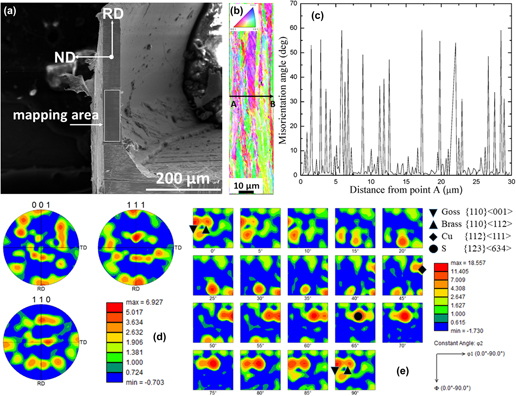Crossref Citations
This article has been cited by the following publications. This list is generated based on data provided by
Crossref.
Zhang, Bin
Dodaran, Mohammad
Ahmed, Shahrior
Shao, Shuai
Meng, W.J.
Juul, K.J.
and
Nielsen, K.L.
2019.
Grain-size affected mechanical response and deformation behavior in microscale reverse extrusion.
Materialia,
Vol. 6,
Issue. ,
p.
100272.
Voyiadjis, George Z.
and
Song, Yooseob
2019.
Strain gradient continuum plasticity theories: Theoretical, numerical and experimental investigations.
International Journal of Plasticity,
Vol. 121,
Issue. ,
p.
21.
Singh, Manpreet
and
Singh, Anant Kumar
2019.
Magnetorheological finishing of micro-punches for enhanced performance of micro-extrusion process.
Materials and Manufacturing Processes,
Vol. 34,
Issue. 14,
p.
1646.
Voyiadjis, George Z.
and
Song, Yooseob
2020.
Gradient-Enhanced Continuum Plasticity.
p.
95.
Zeng, Congyuan
Zhang, Bin
Hemmasian Ettefagh, Ali
Wen, Hao
Yao, Hong
Meng, W.J.
and
Guo, Shengmin
2020.
Mechanical, thermal, and corrosion properties of Cu-10Sn alloy prepared by laser-powder-bed-fusion additive manufacturing.
Additive Manufacturing,
Vol. 35,
Issue. ,
p.
101411.
Zhang, Bin
and
Meng, W. J.
2020.
Scaling Anomaly in the Mechanical Response in Microscale Reverse Extrusion of Copper.
Journal of Micro and Nano-Manufacturing,
Vol. 8,
Issue. 1,
Song, Yooseob
and
Voyiadjis, George Z.
2020.
Strain gradient finite element model for finite deformation theory: size effects and shear bands.
Computational Mechanics,
Vol. 65,
Issue. 5,
p.
1219.
Song, Yooseob
Garcia-Gonzalez, Daniel
and
Rusinek, Alexis
2020.
Constitutive Models for Dynamic Strain Aging in Metals: Strain Rate and Temperature Dependences on the Flow Stress.
Materials,
Vol. 13,
Issue. 7,
p.
1794.
Gu, Sen
Zhu, Junhui
Pan, Peng
Wang, Yong
and
Ru, Changhai
2020.
A Miniature Piezoresistive Transducer and a New Temperature Compensation Method for New Developed SEM-Based Nanoindentation Instrument Integrated With AFM Function.
IEEE Access,
Vol. 8,
Issue. ,
p.
104326.
Zhang, Bin
Meng, Andrew C.
and
Meng, W.J.
2021.
Deviation of mechanical behavior in microforming from continuum scaling: A geometrically necessary dislocation storage perspective.
International Journal of Machine Tools and Manufacture,
Vol. 169,
Issue. ,
p.
103795.
Zhang, Bin
Namakian, Reza
Zhang, Xiaoman
Meng, W.J.
Hay, Jennifer
and
Johanns, Kurt
2021.
A novel approach for microscale dry contact stiction and friction assessment: Experimentation and analysis.
Materials & Design,
Vol. 212,
Issue. ,
p.
110207.
Zhang, Bin
Ding, Huan
Meng, Andrew C.
Nemati, Saber
Guo, Shengming
and
Meng, W.J.
2023.
Crack reduction in Inconel 939 with Si addition processed by laser powder bed fusion additive manufacturing.
Additive Manufacturing,
Vol. 72,
Issue. ,
p.
103623.
Venkatesh, B.
and
Panigrahi, S.K.
2024.
A superplastic micro-extrusion technology to develop engineered magnesium micro-components.
Journal of Materials Processing Technology,
Vol. 327,
Issue. ,
p.
118350.
Zhang, Bin
Dahlberg, Carl F.O.
Fischer, Tim
Hutchinson, J.W.
and
Meng, W.J.
2026.
Non-proportional plastic deformation at the micron scale: Single crystal Cu cantilever beams subjected to orthogonal bending.
Journal of the Mechanics and Physics of Solids,
Vol. 206,
Issue. ,
p.
106375.


